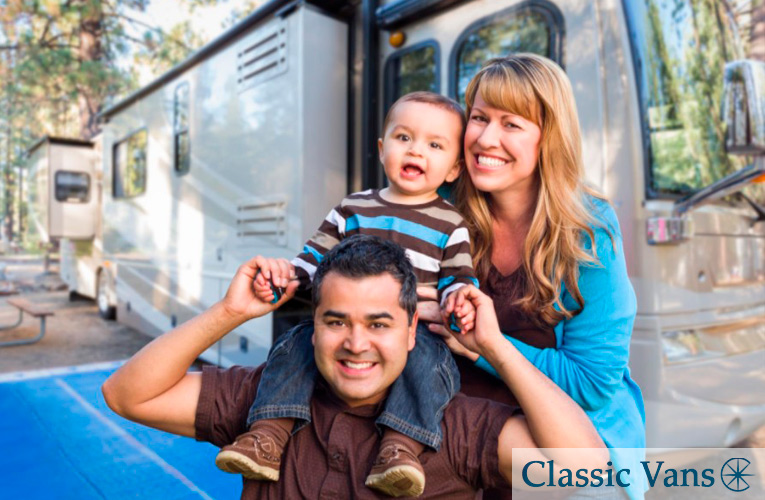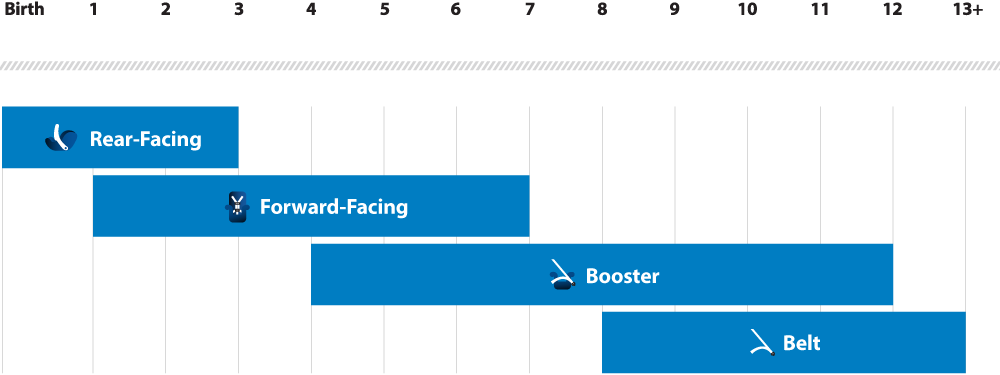A complete family guide to going on a road trip with itty bitties
There are so many reasons why traveling in a class B motorhome, RV or campervan is ideal for families. In addition to being flexible to a small child’s needs, RVing is great for family bonding. Motorhome trips offer the perfect opportunity to disconnect from technology. In addition to quality time, campervan travel teaches kids about the value of teamwork and the importance of connecting with nature.
If you’ve never taken a campervan trip before (or if you’re a seasoned pro but are planning to bring along small children for the first time), being well prepared can go a long way. As you may know, taking young kids anywhere requires lots of planning.
We hope the following tips, tricks and suggestions help make your next family road trip a huge success!
Tip #1: Choose the right campervan
When it comes to picking the best travel vehicle for your family, it certainly can be said “to each their own.” But keep in mind that traveling with two adults plus a baby or young child is a lot different than just traveling as a couple. Prior to having kids, your basic van may have been perfectly suited for you and your partner. After having a little one, though, comfort and functionality will become a huge priority.
For starters, think layout versus size. You may not necessarily require much more space with a baby or small child onboard; however, you could be in a pickle if the layout of your van or RV isn’t suited for installing a carseat. Not all couches in a motorhome or RV are able to hold a carseat.
Another factor to consider is where you plan to set up your infant/toddlers play pen for sleep. Can the vehicle’s table be removed so a pack n’ play can be set up inside?
As your kids grow, seating and space for sleeping tends to be less of an issue. Many children love sleeping in motorhomes above the driver’s seat as many class B camper vans have. The key is to think realistically about how much space you require and where you want everyone to sit/sleep. If your current rig seems fine, visualize your layout.
If you’re concerned about making everyone fit, consider trading in for a vehicle that’s more suited to your new needs and growing family.
| Check out our Conversion Van Buying Guide to get started. |
Tip #2: Obey car seat safety laws
While there are no state-specific laws that say at what age it’s okay to bring an infant on board a RV or motorhome, you should make sure to comply with all national car seat safety laws. You can find your state’s car seat laws here: https://saferide4kids.com/car-seat-laws-by-state/.
The National Highway Traffic Safety Administration also provides the following child car seat recommendations based on your child’s age and size:
In addition, keep the following tips in mind when it comes to installing car seats and riding with children in a motorhome or RV:
- Never install an infant or child seat in a side facing seat.
- Be sure your child’s car seat harness is securely attached to the forward facing seat you designate for them.
- Don’t install the car seat in the front seat of your motorhome.
- Make sure the chair you’re installing the car seat to is secured to the chassis (versus the interior of the motorhome).
- Avoid installing a child car seat onto a seat that turns or swivels.
- Be sure no loose objects from the kitchen or luggage compartment can fall and hit your child in the event of a turn, hard brake or an accident.
- For all kids (and adults for that matter), it’s important they remain seated and buckled at all times while the vehicle is moving.
Tip #3: Plan your routes
Owning a campervan or RV is great because it allows you and your family a level of spontaneity that hotel/resort vacations don’t allow. However, if you’re traveling with a baby or small child who still depends on nap schedules, you may want to be a little more thoughtful about your routes and drive times.
- Try to plan long drives from destination to destination during essential nap times as this is a great way to keep your baby/toddler well-rested and the parents more relaxed.
- Remain flexible about stops and breaks. When your baby or toddler is feeling restless, sometimes stopping at a park or rest area for a quick stretch can help your child get out extra energy.
- You may be tempted to take shortcuts on remote country roads. Keep in mind that getting lost without cell service with a little one in tow could be a nightmare. Consider sticking to better known routes.
Tip #4: Child-proof your vehicle
Fortunately, many RVs and motorhomes are already baby-proofed. But before you take off on any road trip, it’s important to secure loose cabinets or luggage compartments. Bringing a baby or toddler on a motorhome is taking them out of their element. Make sure to store away any dangerous equipment and secure loose items.
Tip #5: Choose campsites and destinations wisely
The campgrounds and areas you may frequented before may not be as suited to your family now that you’re bringing a little one. Consider the following tips when selecting a family-friendly destination:
- If you’re traveling with a small infant, think about protecting them from potentially harsh weather environments. Areas with little or no shade from the sun, as well as below freezing temperatures, may not be the best places to take small children.
- If naps and early bedtimes are an important part of your child’s routine, think about visiting less crowded and more peaceful destinations. Your child may initially feel a bit disoriented and confused when traveling at first, and the last thing you need is loud campfire cheers to wake them up in the middle of the night. On the flip side, no one wants to be the family that keeps the entire campground up at night with a screaming baby. Picking a site on the outskirts of a campground may be your best bet.
- If your child is a bit older and able to move around on their own (18 months to 3 years old), make sure the campsite you choose is safe for exploration. At this age, toddlers want to explore EVERYTHING! Selecting a campsite next to a steep ravine, cliff or cactus patch probably isn’t a good idea.
- No one wants to be eaten alive by bugs! Babies and toddlers are especially vulnerable to insect bites. Kid-safe repellent can help a little; however, most products can only be applied to babies older than 2 months. Consider choosing a location with less humidity to protect your little one from being extremely uncomfortable with bug bites.
- If it’s your little one’s first camping trip, it may be wise to choose a location relatively close to home. Posting up in your campervan an hour or so away from home may not seem like an adventure, but keep in mind that camping with an infant/toddler is an entire new experience in itself.
Additional Motorhome & RV Camping Advice by Age
Depending on your little one’s age, your trip might look different. Keep in mind these factors to help ensure you have the most positive experience while traveling with your child:
- Pre-crawling age (6 weeks to 6 months) – This is surprisingly one of the easiest times to camp with a child because you don’t have to worry about them running off, getting lost or accidentally hurting themselves. The main concerns for taking an infant camping are usually around sleep and temperature. We suggest investing in a cozy portable crib to help them sleep. Also, bring lots of layers of clothes for cool nights and be aware of rising temperatures.
- Crawlers and toddlers (6 months to 3 years) – This is likely the most difficult age for motorhome trips and RV camp outs. Experienced parents know that this age is full of exploration and unpredictable temperament. Accepting ahead of time that your little one will be covered in dirt is a good place to start! Consider choosing a spot with lots of shade and grass. Also, don’t forget to bring an outdoor play tent to help your rugrat expend their energy in a safe environment. Having a high chair at the picnic table and for use inside your campervan is recommended for feeding time.
- Preschool an older (3 years plus) – This age is magical for camping. Preschoolers are interested in the environment around them and will likely enjoy being in nature. This age still requires lots of supervision though, so be sure to choose a safe and open camping spot where it’s easy to monitor them. Again, accept that your little one will probably get dirty and that’s okay.
Advice for Parents
Above all, remember to relax! Camping is a time to let loose and enjoy your surroundings. The first time you take your baby or toddler on a campervan trip will be a learning experience. Little ones tend to love being outside. If you allow them to explore nature, they will enjoy your family trips more and more. By the time they’re in elementary school, you will all be seasoned pros!
Looking for a new campervan or motorhome for your growing family? Classic Vans is the Bay area’s largest dealer of new and used campervans, conversion vans and mobility vehicles. For over 30 years, we’ve been providing customers with the road trip vehicles of their dreams.
Contact us today for help finding your next family motorhome.
Don’t live in California? No problem. Classic Vans provides low-cost nationwide van-delivery.
Financing is also available.

